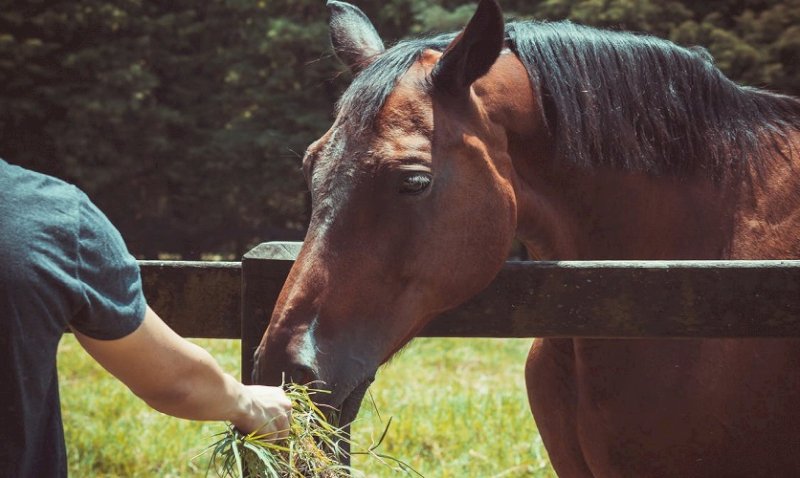All About Lucerne Hay - Perfect Forage for Your Horse
- Dec 07, 2021
- 2399 views
- Share

Mixed farming system in Western Australia is known for its wide implementation of Lucerne hay as alternative forage for animals, especially horses. Besides grass hay and oat chaff, lucerne hay is a great source of necessary fibres and nutrients.
Widely known as alfalfa or ‘al-fasfasa’, this is a well-appreciated ailment for horse digestion as it provides the required nourishment along with vital vitamins and minerals to the horses. If you are a horse lover you would possibly prefer this perennial pasture legume, but others might not.
Wanna know why? Keep reading to get all the required information about temperate fodder!
What is Lucerne hay?
Lucerne or alfalfa or Medicago Sativa, a deep-rooted seasonal flowering plant that belongs to the legume family. This leguminous pasture is cultivated in warmer climates especially in Australia and even on some other continents for hay production. The primary use of lucerne hay is livestock feeding, mostly for cattle and horses. This temperate legume is adapted for mixed farming in Western Australia. Moreover, South America, Europe, Africa and even some parts of the Middle East is well known for this hay production.
History of Lucerne Hay
This leguminous temperate forage for horses has been into cultivation since ancient Rome and Greece around 490 BC. Due to its great nutritious benefits it has been in demand among horse lovers or breeders. As per the current production status of lucerne hay, the USA is the only country with a huge production rate. This perennial forage crop has been developed with wide varieties of new breeds after 30 years of cultivation in Australia.
Plant Description
- This deep rooted perennial legume usually lives for four to eight years but the duration can extend upto twenty years depending upon climate.
- Though it offers year-round production, spring or summer are predominantly known for lucerne production.
- It requires deep, well-drained soils with a slightly acid to alkaline pH.
- Optimum temperature requirement for production is 15-25℃ in day and 10-20℃ during night.
- When the plant is young, it resembles a clover and trifoliate round-shaped leaves are seen. On maturity, leaves become elongated, lilac flowers appear and bear fruit with around 10-20 seeds.
- Lucerne has high water consumption and can address rising water tables and increasing salinity.
- These are highly drought resistant and can grow well in limited rainfall patterns.
- These are a valuable asset for the ecosystem as they provide nitrogen to the soil thereby improving fertility and preventing soil erosion.
Nutrient Value of Lucerne Hay
- High grade lucerne hay is a rich source of Vitamin A, E and K.
- It is also a source of protein and fibre that helps boost energy level in horses.
- It is high in calcium content that helps meet the necessary daily dietary requirements for horses.
Nutrient level:
- Protein - 21%
- Calcium - 1.40%
- Phosphorus - 0.26%
- Crude fibre - 25.2%
- Energy - 57.6%
After a brief insight into this perennial fodder, let’s discuss its advantages and disadvantages from the perspective of being a good horse forage!
Positives
- Due to its high nutritious value horses love lucerne hay.
- It is a great source of vital vitamins, minerals, proteins and fibre that keep weight in check and maintain energy levels.
- It is low in starch and water-soluble carbohydrates that makes it safe for laminitic horses and ponies.
- It is high in calories and helps in building muscle.
- Good quality protein-rich hay is utmost essential for horses.
Too much protein isn’t a healthy choice for your horses. Make sure you add this highly proteinous fodder in the diet in such a way that they get a balanced nutrient without leading to any side effects. Lucerne should be added to their diet depending upon their activities and stage of life they are in. Check out when it is actually useful :
- Breeding or growing horses
- When horses are working intensely
- When they are grazing oxalate pastures
- Elderly horses and ponies
Though lucerne hay makes a nutritious forage for horses, some may be intolerant to these. Check out its flip-side for better understanding!
Negatives
- This valuable forage is exceptionally high in potassium and low in sodium. So an additional source of sodium should be implemented into their diet.
- Horses are fed with green grass and grass hay which is rich in potassium. Adding lucerne hay to their diet will increase the potassium level which will create an imbalance in their nutrition, thereby restricting their daily activities.
- High levels of phytoestrogen content in lucerne hay may affect the cycling of mares eventually leading to reproductive issues.
- Lucerne hay is rich in photodynamic (fluorescing) pigments which cause the depigmentation of sensitive horse skin in the nose and legs when they are exposed to UV rays after the pigments enter the bloodstream. Mix it with ryegrass and clover to control its adversities.
- Mud-fever, sun-burning or photosensitivity are some of the reasons why lucerne hay might not always be good for horses.
- High calcium content in lucerne hay may also lead to electrolyte depletion among some horses. As they will drink a lot and urinate more to expel nitrogen from the protein, which might disturb their health.
Conclusion
Though negative aspects of alfalfa might hold one back from feeding their horses, the benefits are great. They meet the regular nutrient requirement and even helps dealing with gastric ulcer issues among horses. Looking for lucerne hay for sale? Check out Farmtender to get the best quality at best prices in and around Australia!











Share Ag articles Via